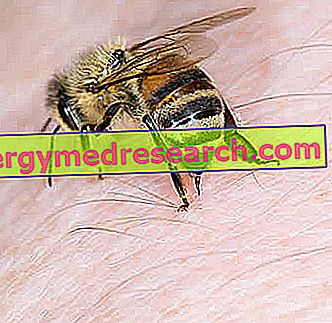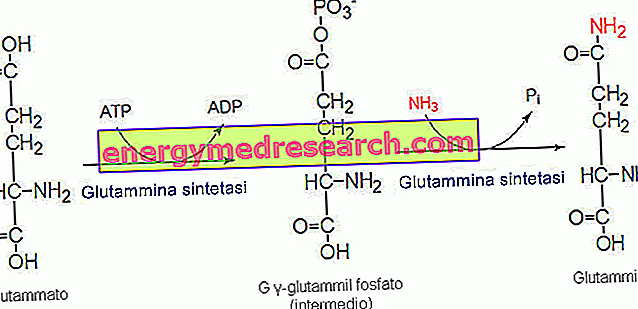Generality
A bee sting is an occurrence that must be considered especially in the summer months. Close contact with the sting this insect can cause different consequences, ranging from temporary local pain to severe allergic reaction (anaphylactic shock).

If the bite of a bee does not cause too intense symptoms, to limit the discomforts it is possible to carry out simple first aid maneuvers (removal of the sting, application of ice etc.). If a more severe reaction develops, it is advisable to request immediate medical intervention. If you have a proven allergy, you should always carry a disposable adrenaline based preparation, to be self-administered in case of need.
What's this
Bee stings can trigger a moderate local reaction or a more severe allergic response. Normally, the entry of the sting into the skin causes immediate pain, burning, itching, redness and swelling; these symptoms resolve within a few hours and are due to the irritating and toxic substances inoculated by the insect.
In previously sensitized people, however, the bite of a bee can induce a local allergic reaction (erythema, extensive edema and intense pain) or systemic (hives, dizziness and difficulty breathing). Sometimes, serious complications may arise that lead to anaphylactic shock.
Causes
In temperate climates, from spring to autumn, being stung by a bee is not a rare event. This insect is recognized by the stocky body, reddish brown, with black and yellowish streaks. The legs are covered with tufts of hair, which allow them to collect pollen from the flowers.
Bees are equipped with a serrated sting, connected to a gland that contains a poison. The latter causes local toxic reactions in all subjects and allergic phenomena only in those previously sensitized.
The bees typically sting once and leave the sting in the wound, and with it the last segments of the abdomen and part of the viscera; so mutilated, these insects are generally destined to die.
Bees are unlikely to annoy or sting, unless they are provoked, if they seriously consider themselves or their hive.
Bee poison (apitoxin)
The poison of the bees is accumulated in a blister and, during the insect bite, is injected into the wound produced by the sting.
The bee venom contains a mixture of toxic substances and components with allergenic activity.
- Toxic substances are responsible for a vasodilator effect, which becomes evident, after a puncture, with mild skin reactions (relief wheal, red and itchy, associated with pain or burning in the injured area).
- Allergens carried by a bee sting are able to trigger an allergic reaction only in predisposed individuals. These substances, like the proteins present in the poison, act within a few minutes, causing different symptoms.
The sting accompanied by the venom gland continues to inject venom into the tissues for several minutes after the puncture (for this reason, if it remains in the skin, it should be immediately removed). The component responsible for the pain is mainly the melittina.
Subjects at risk
Exposed to a greater risk of incurring a bee sting are those who, by profession or outdoor activity, live in close contact with this insect, ie beekeepers, gardeners, farmers and firefighters.
Those who have already been stung by an hymenopter and developed an allergic reaction are predisposed to show a more serious symptomatology. People exposed to swarm attacks and those with high levels of poison-specific IgE are at greater risk of anaphylaxis.
Symptoms and complications
The severity of a bee sting depends on the dose of inoculated poison and the extent of the previous sensitization.

A rare complication of bee sting is bacterial cellulite . This develops one or two days after contact with the insect (therefore not immediately) and is considered when, in addition to erythema and swelling, the pain is significant and systemic signs of infection occur (eg fever and chills).
In susceptible individuals, however, bee sting can induce a toxic or allergic reaction of varying degrees.
In some cases, this may involve more extensive local signs, such as:
- Swelling with a diameter greater than 5 cm compared to the site where the puncture was inflicted;
- Pain, redness, itching and burning that tend to worsen gradually in the first two days, after contact with the insect.
This symptomatic picture tends to resolve within 7-10 days.
Other times, the allergic reaction to the bee sting can involve different parts of the body and induce immediate systemic manifestations (from a few minutes up to two hours after the sting), including:
- Generalized urticaria (rash with itching and redness on a larger area);
- Angioedema (swelling that mainly affects the face and lips);
- grade fever;
- Palpitations;
- Sense of nausea or abdominal cramps;
- Fatigue.
When the swelling involves the tongue or the lower part of the throat it can hinder the passage of air, limiting the respiratory function. Consequently, edema of the glottis can occur (swelling of the larynx at the level of the vocal cords), with an inability to take breath, difficulty swallowing, hoarseness and coughing.
Severe obstruction of the respiratory tract usually manifests itself with difficulty speaking, chest pain, wheezing, headache and a sense of suffocation.
In severe cases, anaphylactic shock may develop after a bee sting. This is characterized by a marked and persistent reduction in blood pressure, which can lead to numbness or loss of consciousness, dizziness and cardiovascular arrest.
In case the bees are particularly aggressive and if they are surrounded by a swarm, it is possible that the bites are multiple . If these exceed the dozen, the accumulation of poison can induce a toxic reaction, which is manifested by nausea, vomiting, dizziness, convulsions, fever and loss of consciousness. This condition represents a medical emergency, as it can evolve rapidly and induce the typical signs of poison poisoning (poisoning), with damage to muscle tissue (rhabdomyolysis), heart problems and kidney failure.
Diagnosis
The diagnosis of a bee sting is clinical: the doctor first checks the area of the skin involved to check the presence of the sting or part of it. Subsequently, the upper and lower airways are examined to identify any signs of an allergic reaction.
Therapy
First intervention
In case of bee sting, it is important to act promptly.
First of all, after contact with the insect it is best to remove the sting as soon as possible if it is stuck in the skin. To check the presence of this appendix of the insect at the site of the puncture, it must be observed if at the center of the wheal there is a darker point. The suggested methods include scraping with a thin-edged tool (eg credit card, table knife, etc.). During this operation it is important to try not to tighten the sting of the bee between your fingers, trying to extract it from below, since the poison bag attached to it could continue to inoculate other poison. Furthermore, the use of an instrument not previously disinfected, such as tweezers or limes, could predispose to infections.
In the absence of allergic episodes, if the patient immediately feels a lot of pain after a bee sting, it is useful to apply an ice cube or immerse the affected area in cold water . The ideal would be to have a first aid kit available, also equipped with ice that can be activated instantly (you can buy it at the pharmacy, parapharmacy or at the supermarket). In addition, to relieve burning, pain and itching, it is possible to use the appropriate post-puncture sticks to be applied to the painful area.
When the symptoms do not tend to persist, however, it is always necessary to consult the doctor, who can indicate the application of cortisone-based creams . Depending on the case, the use of antihistamine lotions (eg diphenhydramine or tripelennamine), NSAIDs, patches with lidocaine or other topical anesthetics may also be useful.
If the allergy is not yet known
People who do not have a known hypersensitivity to bee stings, but develop hives, dizziness and difficulty breathing within a few minutes should contact their doctor or call 118.
While waiting for help to arrive, it is a good idea for allergic people who are pricked by the bee to remain flat and, if unconscious, to be placed in a lateral safety position. Allergic reactions must be treated with systemic antihistamines ; Anaphylaxis should be treated with parental adrenaline and intravenous fluids and, if necessary, with vasopressors.
When the reaction is important, it is necessary to schedule a visit to the allergist, to ascertain his own susceptibility to bee stings and to understand the gravity of the situation by performing tests (determination of specific antibodies in the blood, skin test with poison extracts of bee etc.). The doctor can also prescribe emergency medications, to be used in case of possible future bites (kit containing a pre-filled syringe of adrenaline to take with him), and, when necessary, may indicate a desensitizing immunotherapy . The latter approach may require several years of treatment, but effectively reduces the likelihood of new anaphylactic episodes and systemic reactions to bee stings.
If the allergy is known
People with allergies who have been stung before and who have developed a severe allergic reaction may resort to emergency therapy. This consists of the injection of adrenaline, contained in a special autoinjector (to always carry with you, as indicated by the doctor) in the anterolateral part of the thigh. At the same time, you need to go to the nearest emergency room and consult your doctor immediately, taking the device with you.
Prevention
The adoption of certain behaviors can help to minimize the risk of being stung by bees. In particular, during sports, excursions, picnics or outdoor activities (gardening, beekeeping, etc.) it is advisable to observe the following precautions:
- Avoid too fragrant cosmetics that can attract insects (such as body fragrances, deodorants, hair sprays and creams);
- Do not wear loose clothing that is dark or too bright. In case you want to take a walk in the woods or practice gardening, it is preferable to choose long-sleeved trousers and shirts, shoes and hats in order to minimize exposure to the skin;
- Do not try for any reason to crush the bees and do not use your arms to make them fly elsewhere. If you approach a hymenopter, stay calm and try to move away slowly, without making sudden movements, which could attract the swarm;
- Use caution when working outdoors, in the attic or on roof cornices;
- If possible, provide mosquito nets with doors and windows to prevent insects from entering the house.
- During outdoor activities, do not walk barefoot, cover food and drinks that are not consumed and seal the waste;
- Use insect repellent products on exposed skin when outdoors;
- Do not get too close to bee hives and, if reclamation is needed near your home, contact experienced and specialized personnel;
- Do not use insecticides for mosquitoes or other insects: their action is slow and, usually, bees make time to bite anyone in the vicinity before they die.



